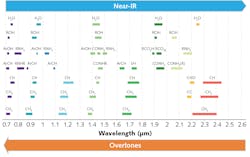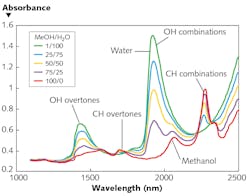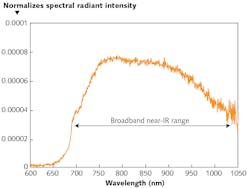LED light source enables mobile spectroscopy for industry and consumer use
CHRISTOPH GOELTNER
The food industry sometimes comes under fire for its use of genetically modified organisms, inaccurate labeling, or insufficient quality control, which can lead to product recalls. As a result, consumers have an incentive to check for themselves whether the items they eat really contain the ingredients listed on the packaging. The good news is that technology is allowing this to happen: so-called ag-tech (agricultural technology) is now a rapidly growing industry because it can offer an increasingly detailed understanding of the qualitative and quantitative composition of food and other agricultural products.
Some of the biggest advances in the food industry are being made possible by technological innovations such as near-infrared spectroscopy, which can identify certain compounds like fat, sugar, water, and proteins in food, leading to information about calorie content, freshness, and quality of food that can help consumers make better choices. By analyzing the absorption spectrum of an unknown material and matching this measurement with a database of known molecules, it is possible to determine the presence and quantity of certain ingredients—for example, the percentage of cocoa in a chocolate bar.
Quantitative and qualitative analysis
Infrared (IR) light stimulates the molecules in a material, causing them to vibrate; due to resonance, an atomic compound with a certain binding energy is stimulated by a photon with the same energy. Depending on the type of atomic bond, certain fundamental vibrations, harmonics, and combination vibrations can be measured in the IR range. A characteristic atomic connection thus occurs in several wavebands, depending on whether it is a fundamental or a harmonic vibration (see Fig. 1). In the near-infrared (near-IR), usually only harmonics are found.
In terms of food analysis, one of the goals is to determine the percentage of corresponding ingredients, such as sugar, fat, or water content. This method is called quantitative spectroscopy. However, in most cases, the object to be analyzed does not consist of a laboratory-pure mixture. As a result, the identification of the ingredients in complicated and unknown substances can be difficult to pinpoint because the individual oscillations can overlap in the overall spectrum. In contrast to the quantitative analysis mentioned above, this is a qualitative analysis. The mathematical models used here are much more complex and have to be geared to a reduced target quantity in order to achieve meaningful results.
As a result, there has not yet been a release of a handy spectrometer that consumers can carry in their pockets to get an immediate, detailed analysis of every piece of food they eat. Fortunately, however, the first steps toward this reality are now being made. In the near future, a mobile handheld spectroscope could ultimately be used to scan a wide range of materials—food, medicine, even the human body—and analyze them in real time.
On the path to mobile spectroscopy
A spectrometer consists of four main building blocks: a light source, a detector, optics, and a statistical mathematical model (so-called chemometrics), which derives meaningful information from raw data. The photoresponse of silicon-based detectors extends to just over 1000 nm; for longer wavelengths, sensors based on gallium arsenide are needed. The 780–1000 nm spectral region crystallizes out as a meaningful measuring range because it shows measurable characteristic curves for almost all key substances.
Traditional spectrometers use conventional halogen light sources. However, LEDs offer a better alternative because of their high efficiency, stability, and longevity, and because they can produce a broad spectrum with uniform intensity. Osram has developed two specialized near-IR broadband emitters, SFH 4736 and SFH 4776, that are targeted for spectroscopy applications.
Conventional white LEDs are optimized for illumination purposes, usually showing multiple intensity maxima. For near-IR applications, the challenge is to create a spectrum that illuminates the target range of 780 to 1000 nm as uniformly as possible. Fortunately, this can be achieved with the help of a special phosphor conversion. A blue LED is chosen as the light source, which excites the phosphor (conversion medium). The luminescence of the phosphor leads to a shift of the emitted wavelength towards the red and IR spectrum. The challenge here is to design the conversion medium so that it achieves a broadband spectrum (see Fig. 2).To measure material characteristics across a spectrum, the spectral range is divided into channels, with each channel corresponding to an individual detector element. At first, mobile spectrometers were equipped with 12 channels. Even with this small number, meaningful measurements can be made. But, because the technology is progressing rapidly, the next generation should offer a resolution of 64 channels.
The first devices of this kind should enter the market in 2020. These higher resolutions will lead to even more accurate measurements, as the race for better sensors has already begun. Here, the central technological prerequisite is to develop filter systems that allow a correspondingly fine graduation of the respective wavelengths. The next step in detector development is to go beyond the silicon-based limit of 1000 nm. Expanding to the longer-wavelength part of the spectrum makes it even easier to identify many substances.
Measuring with a spectrometer
Spectrometer measurements can be divided into two methods: transmissive and reflective. In the case of liquids (see Fig. 3), the transmissive spectrum is usually measured, whereas in the case of solid substances, the reflected spectrum is measured.The quality of the measurement ultimately depends on how precisely the reflected spectrum reaches the respective receiving channel of the detector. To avoid additional geometric effects, a diffuser is placed in front of the detector to reduce distortion of the spectral information. In practice, each detector element has a finite size; ideally, all channels should be in the exact same place.
On the emitter side, the target object should be evenly illuminated at high intensity. This is made possible by traditional lens systems that are either integrated into the terminal or, as with the SFH 4736 emitter, are already part of the LED. It is also important to ensure that no stray light penetrates the object space, which can distort the results.
To derive meaningful information from the raw data measured by the spectrometer, these systems use chemometric methods that rely on mathematical and statistical analysis to relate spectral information to the causative chemical-physical relationships. Figure 1 shows how the main absorption lines change in proportion to the concentration. The challenge is to derive from this information a quantitative model that allows one to measure a spectrum and then calculate the mixing ratio.
Since measured data contains inaccuracies, a statistical solution is also required. Advances in the field of artificial intelligence (AI) with powerful computing systems support this complex analysis process. It should be noted that the accuracy of AI solutions depends on how well the model has been trained. Determining reliable training data requires considerable effort, which can then only be used in specific scenarios.
Reaping the rewards of spectroscopy
Farmers have been using a variation of mobile spectrometers for more than ten years in their quest to improve the growing process and optimize crop yields. The exact composition of the soil, for example, could previously only be determined with elaborate laboratory analysis. Advances in near-IR soil analysis now allow for real-time, on-site, and in-depth analysis.
During the crop-growing process, farmers are now deploying remote-controlled near-IR sensors that can determine essential plant components in real time across their fields. Nitrate and water content, for example, are important indicators of the health of a crop. Today’s robotic sensors not only determine the target parameters using near-IR spectroscopy, but they also come with built-in fertilizer containers for immediate crop refertilization. What’s more, an integrated GPS system can show the farmer how to better control the irrigation system.
Water content is a decisive parameter during harvesting. Most bulk goods, including most agricultural products, are traded by weight. Water content is thus a key determinant of the value of a product. In the past, this could only be done in a lab, as it was a time-consuming and cumbersome process. Today, however, near-IR technology can quickly and accurately determine water content during the production process, and it can do it without damaging the product, which is a critical. For instance, near-IR spectrometers can be mounted directly in the feed tube of a forage harvester. The spectrometers constantly monitor the water content, which allows the load weight of the filled trailer to be determined without having to place the objects on a scale.
Food processing involves a number of well-established steps, such as the mixing ratios of respective substances and the quality determination of goods at the time of receipt. Typically, these tests are randomly controlled by the appropriate internal or external laboratories. Complete monitoring has not been possible so far. Near-IR spectroscopy enables the durability of this monitoring and can also be integrated into the process flow.
The use of spectroscopic sensors in smartphones and other portable devices will soon be a reality, offering tremendous benefits to society. Mobile spectroscopy will allow both consumers and producers to have real-time access to more-reliable information, making it easier for farmers to improve the growing process and for consumers to better understand what they are eating.
Dr. Christoph Goeltner is product marketing manager at Osram Opto Semiconductors, Regensburg, Germany; e-mail: [email protected]; www.osram.com.


